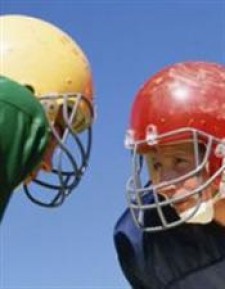Routine Head Hits in School Sports May Cause Brain Injury
Routine Head Hits in School Sports May Cause Brain Injury
November 14, 2011
The brain scans of high school football and hockey players showed subtle injury — even if they did not suffer a concussion – after taking routine hits to the head during the normal course of play, according to a University of Rochester Medical Center study.
The research, reported online in the journal Magnetic Resonance Imaging, is preliminary, involving a small sample of athletes, but nonetheless raises powerful questions about the consequences of the mildest head injury among youths with developing brains, said lead author Jeffrey Bazarian, M.D., M.P.H., associate professor of Emergency Medicine at URMC with a special interest in sports concussions.
Bazarian and colleagues used a cutting edge statistical approach to analyze before-and-after images of the players’ brains from diffusion tensor imaging (DTI). A DTI scan is similar to an MRI but it does not relay pictures, rather it captures and relays quantitative data that must be decoded and interpreted.
Collaborators and co-authors Tong Zhu, Ph.D., and Jianhui Zhong, Ph.D., uniquely applied a novel (wild bootstrap) statistical method to the DTI imaging study and detected the small but noteworthy changes in the white matter of the teenagers.
“Although this was a very small study, if confirmed it could have broad implications for youth sports,” Bazarian said. “The challenge is to determine whether a critical number of head hits exists above which this type of brain injury appears, and then to get players and coaches to agree to limit play when an athlete approached that number.”
Nine athletes and six people in a control group from Rochester, N.Y., volunteered to take part in the research during the 2006-2007 sports season. Among the nine athletes, only one was diagnosed with a sports-related concussion that season, but six others sustained many sub-concussive blows and showed abnormalities on their post-season DTI scans that were closer to the concussed brain than to the normal brains in the control group.
The imaging changes also strongly correlated with the number of head hits (self-reported in a diary), the symptoms experienced, and independent of cognitive test results, Bazarian said.
The URMC study is unique because it was able to compare brain scans from the same player, pre-season and post-season. Most other studies compare the injured brain of one person to the normal brain of another person from a control group. However, that becomes a problem when searching for very subtle changes, Bazarian said, because so much natural variation exists in every individual’s brain.
Indeed, among athletes there is no easy, objective way to diagnose concussions. High schools, colleges, and professional programs routinely administer pre-season, computer-based cognitive tests. Yet some athletes have become adept at tricking the test, Bazarian said. They intentionally do poorly on the baseline so that a mild concussion will not show up if re-tested later.
The DTI scan provides detailed information of axonal injury at the cellular level, by measuring the motion of water in the brain. Axons, which are like cables woven throughout brain tissue, swell up when injury occurs. As the swelling impacts the movement of water, scientists can measure changes in flow and volume and thus make an educated guess at the extent of axonal injury.
Measurements in the study at hand showed many changes in the brain of the player with the diagnosed concussion; however an intermediate level of changes also occurred among the players who reported anywhere from 26 to 399 total sub-concussive blows. The fewest changes occurred in the control group, as expected.
A key objective of the study was to determine if this statistical approach worked, and the preliminary results showed that white matter changes among the intermediate group were three times higher than the controls.
Efforts to further understand the significance of study results are already underway. Bazarian and collaborators at the Rochester Center for Brain Imaging, the URMC Department of Emergency Medicine, Department of Athletics and Recreation, and the Department of Imaging Sciences, are working on an NFL-funded study of UR football players this fall. Ten players agreed to wear helmets with special sensors that objectively detect the number of head hits they sustain, the velocity and angle. Each player is also receiving a pre-season and 2 post-season DTI scans, and the data downloaded from the helmet sensors will be correlated with information from the images.
“Our studies are taking important steps toward personalized medicine for traumatic brain injury,” Bazarian said. “In the future we’d like to be able to have a baseline image of a brain and clearly know the significance of changes that occur later.”
Funding was provided by the National Institutes of Health and the UR Health Sciences Center for Computational Innovation.
###
* The above story is adapted from materials provided by University of Rochester Medical Center
![]() ______________________________________________________________________
______________________________________________________________________



















